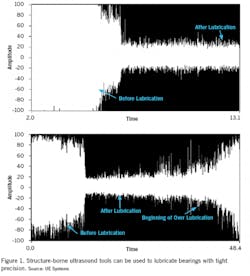Did you know that an energy efficient facility can be directly linked to its reliability and success? Are you aware of how important it is to consistently report and document results to generate awareness and effectively reduce your energy usage? What about how important it is to be proactive instead of reactive to prevent problems from happening in the first place?
Common sense will have you answer these questions with, “Yes,” but the way you run your facility could be suggesting otherwise.
You might be thinking, “I’d like to find a way to be more efficient, but I don’t like change! We don’t have the time to completely reinvent the way we do things!” Or, “The way we have been running our business has been working to this point, so why fix what isn’t broken?” Well, if this sounds like you, good luck!
What is ultrasound?
By definition, ultrasound is a sound wave with a frequency higher than the upper audible limit of human hearing. Using ultrasonic technology, we can transmit sounds the human ear cannot hear through a process called Heterodyning, which translates those noises into a range that is audible to the human ear. The sounds then are heard in a headset and displayed and stored in an ultrasonic instrument. These data then can be used to provide early warnings of asset failure, enabling plant teams to be proactive and fix problems before they become even more serious and costly.
The beautiful thing about ultrasonic frequencies is that they can be used in almost any environment, and the sound waves are directional, which means they will point you exactly in the right direction where the leak or problem is occurring.
There are five easy ways to reduce energy waste using ultrasound technology. These are:
- Compressed Air Leak Detection
- Compressed Gas Leak Detection
- Steam Trap Testing and Inspection
- Mechanical Efficiency and Friction
- Carbon Footprint Reduction
If you implement these five practices into your facility, you will notice improvements in the efficiency of your facility, a reduction in your carbon footprint, and an increase in your annual cost savings.
1. Compressed air leak detection
Did you know compressed air is a facilities’ most expensive utility? This means locating and fixing compressed air system leaks is critical to maintaining good energy efficiency and significant cost savings. In fact, industry experts estimate that as much as 30% of all generated compressed air is lost due to leaking. That can add up quickly!
Ultrasound tools can be used to quickly identify leaks in plant compressed air systems, so maintenance teams and select an immediate course of action to remedy the leaks. A common leak-detection method is termed “Gross to Fine,” which the ultrasound instrument operator starts at a greater distance from the leak and gradually moves closer in order to narrow the point down as the sound becomes clearer. Eventually, the exact location of the air leak will be found, so you can plan a course of action.
2. Compressed gas leak detection
Undetected gas leaks can cost tens of thousands of dollars per year, depending on what type of gas you are using. Specialty gasses such as argon, helium, or hydrogen will cost you even more. What seems like a minimal difference day to day turns into something catastrophic over the course of 365 days.
While there are obvious financial benefits in preventing gas leaks and further damage, it does not stop there. Gas leaks are not only a safety hazard for employees, they are also detrimental to the environment. Getting any gas leak under control will give you an instant payback and ensure your facility is running at optimal efficiency for both you and your employees.
3. Steam trap testing and inspection
A typical facility can generate steam savings of 20% or more by improving its steam system. Additionally, approximately 20% of the steam leaving a central boiler plant is lost through leaking steam traps in a typical heating system without any proactive assessment programs.
Why is this important? First and foremost, more than 45% of all fuel burned by U.S. manufacturers is for generating steam. That’s an incredible amount, and savings of 20% or more will make an enormous impact both environmentally and financially for the business.
There are several simple approaches that can be taken with ultrasonic equipment to pinpoint and reduce leaks in your steam systems. These include insulating steam and condensating return lines, stopping any steam leaks, maintaining steam traps, and being consistent with your routes, testing, and inspection.
4. Mechanical efficiency and friction
Friction is both a good friend and a dangerous enemy. As the saying goes, it’s important to keep your friends close and enemies closer. Friction is the ultimate source of ultrasound, so it is vital to keep a close relationship with friction. While friction is important to pinpoint the exact issue occurring, too much friction can: create excessive heat, contribute to energy loss, utilize a greater amount of power to overcome, cause expansion, cause a bearing or sliding surface to fit tighter, and much more.
Some of the biggest culprits of friction are over and under lubricating bearings, using contaminated lubricants, or using the wrong bearing type entirely. Figure 1 shows how structure-borne ultrasound tools can be used to lubricate bearings with the precise amount of grease necessary.
5. Carbon footprint reduction
Power generation and industrial manufacturing make up 50% of total greenhouse gas emissions in the United States, primarily from the burning of fossil fuels as well as certain chemical reactions that are necessary to produce goods from raw materials.
Your plant’s facility manager will have a solid understanding of your company’s overall sustainability goals, as well as how each department in your organization contributes to these goals, including the maintenance reliability functions. The more savings you quantify from the four methods outlined above, the easier it will be to contact the facilities team, roll those numbers up, and identify your overall contribution to the sustainability goals of your plant. Helping the planet by reducing your plant’s carbon emissions can help your team stay motivated to pursue further energy efficiency/reduction initiatives.
In conclusion, the five methods to reduce and quantify energy waste with ultrasound covered in this article are just the beginning. If you want your facility running at optimal efficiency, these are the very first steps that you can take to reach that goal. Ultrasound plays a major role in helping reduce energy inefficiencies, and is a good reason to incorporate energy management into your reliability program.
While the information might seem like a lot at first, energy applications for ultrasound are some of the easiest to use and deploy. Reliable assets help make reliable facilities, and reliable facilities and more likely to be efficient facilities. It is about making more with less and being efficient with your resources.
Adrian Messer, CMRP, is the manager of U.S. operations for UE Systems Inc. For more than a decade, Messer has been helping facilities around the country transform their reliability programs by successfully implementing ultrasound technology for condition monitoring and energy conservation applications. As a subject matter expert on Ultrasound technology and implementation best practices, Messer has been a featured speaker at numerous industry events. He is also a charter member of the SMRP Carolinas chapter, and is the current interim chapter chairman.
About the Author

Adrian Messer
CMRP, Vice President of Executive Services, Progressive Reliability
Adrian Messer has worked in the maintenance and reliability field for nearly 20 years. During that time, he has worked with manufacturing and distribution facilities across multiple industries helping to improve their plant’s asset reliability through improved condition monitoring. Adrian is Manager of US Operations at SDT Ultrasound Solutions. Previously he worked with Progressive Reliability to advise companies on reliability-focused contracting & hiring and to find M&R professionals for open jobs.
Adrian is a graduate of Clemson University with a Bachelor of Science in Management with a concentration in Human Resources. He is a Certified Maintenance and Reliability Professional (CMRP) through the Society for Maintenance and Reliability Professionals (SMRP) and is actively involved with SMRP on a local and National level. He resides in Anderson, South Carolina.

